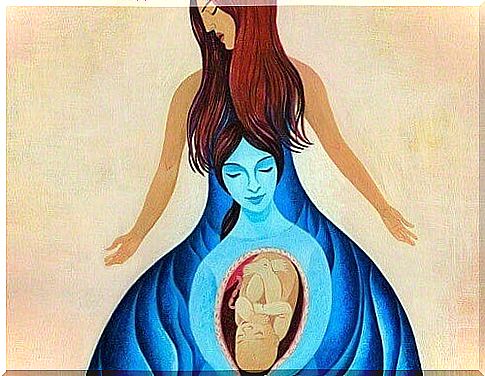Giving Life, The Most Beautiful Act Of Love For Women

It is generally said that giving birth is like a blind date where the mother finally meets the one who will be the love of her life.
There are few things as painful, sacred and at the same time filled with incredible emotions as childbirth, a time in life that also demands special treatment.
If conception was an act of love, giving life should be an act just as strong and full of tenderness.
Between May 16 and 22, we celebrate the respected World Childbirth Week.
Here is something that we should all be aware of and that the WHO (World Health Organization) points out: in recent years, many women have complained that childbirth is sometimes too formal, not very humane and in some cases even traumatic.
Nils Bergman is a pediatrician and neonatologist particularly famous for his studies in the field of perinatal neuroscience.
According to him, one of the most important moments to build a normal bond of affection between mother and child is undoubtedly the “first thousand minutes of life”.
If both mother and baby are under undue stress, all of this could affect the quality of that first emotional imprint in the newborn.
Giving life must therefore be an act of love that must be taken care of. We invite you to reflect on the subject.

Giving birth between pain, emotions and medical protocols
Giving life is a sacred moment for both mother and child.
If we take into account that in recent years, pregnancies have taken place at older ages, we understand that medical attention and precautionary measures are more important to ensure a delivery without complications.
However, keeping in our mind that the attention of professionals in a medical center is essential, which many women complain about and what the WHO has been pointing out in recent years, these are the aspects that we will now present to you. and of which we should be aware.
Childbirth is less and less respectful
Michel Odent, a famous obstetrician and respected childbirth advocate, reminds us that “childbirth is love, and ideally we should ensure that mother and child benefit from this feeling from the first moment. ”.
We have been observing these different things over the past few years:
- The number of cesarean sections has increased dramatically. According to official data, almost 21% of births are carried out this way (remember that cesarean sections replace vaginal birth whenever there is a risk of death for the mother or the child).
- Many women report feeling uncomfortable during childbirth: being exposed to too many professionals during palpations, monitoring, shaving, speeding up labor thanks to synthetic oxytocin or ‘must be placed in a lithotomy position to give birth, they felt a high level of stress in the face of these not very tender protocols.

It is also evident that each mother has an experience of her own.
There are also some for whom it went well, but others will have a somewhat dull or disappointing memory of it because we did not facilitate, for example, something as essential as skin to skin in between. the newborn and the mother.
Respectful childbirth or how to facilitate the emotional bond between mother and child
Giving birth is a painful and magical moment that is also orchestrated by specific hormones and neurotransmitters that have a very specific purpose.
We must realize that at the cerebral level, a neurobiological field is set up which will help the mother to create this first imprint with her baby to build the bond.
If the woman is feeling stressed or scared, all of this can affect the quality of her milk, for example.
If the baby also suffers from this stress and if it is separated very early from its mother to put it “in an incubator”, this can encourage small metabolic and cognitive changes.
Our DNA presupposes this immediate union between mother and child, and if it does not happen, the baby can interpret the world “he lands in” as hostile and cold.
This is why it is important to take into account a series of rules that promote a respectful childbirth during which we can build this bond based on love and an affectionate welcome.

The keys to a birth based on love
There are many types of childbirth, and we are not going to ask ourselves whether it is better to have a natural, drug-free birth with midwives, or to opt for a hospital that also offers “Program” the birth of the child.
What is important, above all, is not to endanger at any time the two protagonists of this wonderful event: the mother and the son.
Each family is free to choose how they want to give birth to their child, but it is best to take into account these simple points:
- The WHO defends what is known as “humanized childbirth”, where the woman has the right, for example, to choose – if there is no danger – the position in which she wants to give birth.
- Careful, loving and intimate treatment should be encouraged to make the mother feel comfortable at all times.
- The umbilical cord should not be cut immediately (when it is not around the baby’s neck). We know that the cord contains hundreds of mother cells, and multiple substances beneficial for the future development of the child, which act for him as “vaccines”.
- Neither should the pocket of the placenta that receives the baby be pierced, as this tissue transmits oxygen-rich blood.
If you have the possibility, it is always better if the pouch is pierced naturally, because this way, you calmly facilitate the onset of pulmonary breathing.
- The newborn must be immediately put in contact with its mother, skin to skin.
It should stay that way for many minutes, because this way we fight stress, facilitate the onset of breastfeeding, regulate heart rate, temperature, blood glucose level, and strengthen the system. baby’s immune system …

To conclude, giving birth is not just a “medical act” governed by an adequate protocol to avoid all risks and dangers.
Respectful and tender births should be encouraged that foster the bond between mother and newborn from the first moment.









